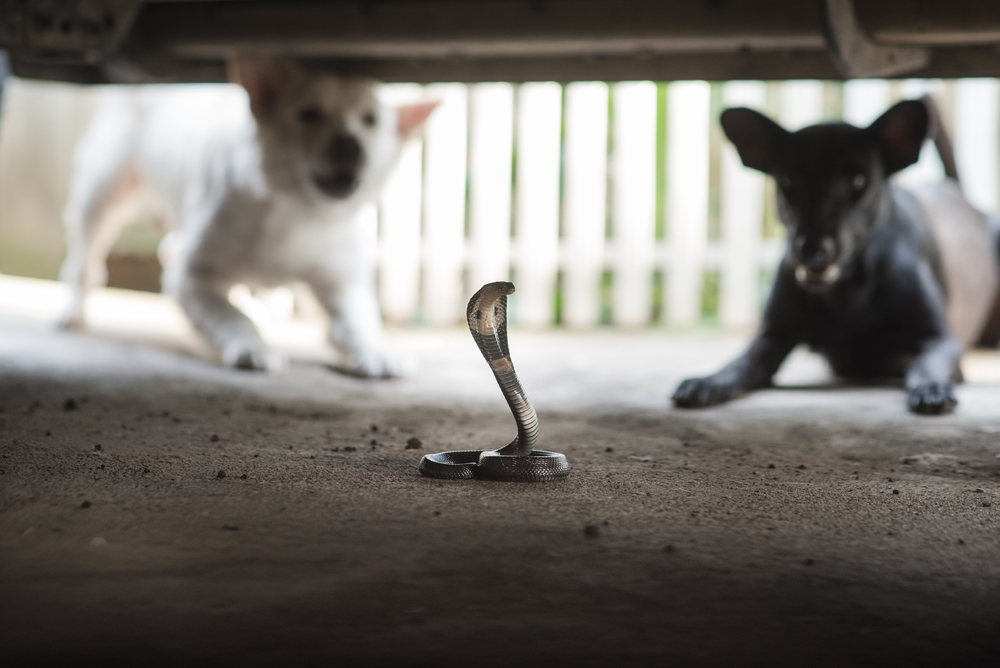We live in a beautiful area, where pet owners have plenty of opportunities to enjoy nature with their pet. But, the beautiful outdoors comes with some risks, including snakebites. Snakes are most active during warm weather, and in Arizona, April through December is considered snake season. You do not need to cancel your outdoor activities because of snakes, but you must take extra precautions when venturing outdoors with your pet. Our team at Palisades Veterinary Hospital is always here to help in an emergency—but we’d rather prevent an emergency. We share five snake awareness and safety tips to help you steer clear of snakes and avoid a life-threatening situation for your pet.
#1: Beware by being aware of you and your pet’s surroundings
When you and your pet are strolling along the trail on a beautiful spring day, you can easily be lost in thought or busy admiring the scenery, but you must stay vigilant and ensure you:
- Watch your step — When parking at a trailhead, watch your step as you and your pet exit your vehicle. Also, watch for holes and stones along the path.
- Use a short leash — While you may be tempted to let your dog walk off-leash or to use a retractable leash to let them sniff and explore, keeping them on a short leash is much safer. You should always keep your pet close, to discourage them from wandering off-trail where snakes are more likely, and to allow you to more quickly pull your dog away from a snake on the path. A short leash also means you can gather your pet up more quickly and easily should they need emergency care for a snakebite or other injury.
- Keep your hands to yourself — To protect yourself and your pet from a snakebite, avoid reaching blindly into bushes or grass—your pet’s favorite tennis ball may have rolled away, but think first before retrieving their toy.
- Leave the headphones at home — Many people enjoy listening to music or podcasts while walking, but this can prevent you from hearing evidence that a snake is close by. So, leave the airpods at home.
- Stay on the path — When walking your pet, stay on the designated trails, and away from areas with tall grasses and bushes.
- Be familiar with common snakes — If you hike regularly with your pet you should be familiar with a rattlesnake’s appearance, as well as other snakes commonly seen in Arizona.
#2: Beware by staying calm during a pet-snake encounter
Staying aware of your surroundings and keeping to designated trails will lower, but cannot eliminate, your chances of a snake encounter. Every pet owner needs to follow these guidelines if they come across a snake:
- Calmly and slowly back away from the snake until you are out of striking distance.
- Leave the area, because one snake usually means more are in the area.
- Do not approach the snake for any reason.
- Let others know of the snake sighting, so they can avoid the area.
#3: Beware by knowing what to do with your snake-bitten pet
If your pet is bitten by a snake, do your best to stay calm and act quickly. Your pet can react immediately with severe, possibly life-threatening signs, so wasting no time is crucial. Use these tips if your pet is bitten:
- Move your pet away from the snake.
- Inspect the bite area—swelling indicates that the snake was likely venomous.
- Do not cut into the snakebite, apply ice or heat, or medicate your pet without veterinary advice.
- Contact your veterinarian, and get your pet emergency care as fast as possible so a veterinarian can assess the bite and determine the necessary treatment. Veterinary care is critical, whether or not you think the snake is venomous.
- Try to remember the snake’s size and appearance to describe to the veterinarian.
#4: Beware of snakes by vaccinating your pet
Your veterinarian can be your best resource for protecting your pet from a life-threatening snakebite by providing safety guidelines. More importantly, they can vaccinate your pet against a rattlesnake’s venom. The rattlesnake vaccine stimulates your pet’s immune system to produce antibodies against the snake venom, and reduces the reaction severity. A vaccinated pet who is bitten by a snake still needs emergency care, but the vaccine does provide added protection. Ensure your pet is up to date with all their vaccinations, including the rattlesnake vaccination, before hitting the trails.
#5: Beware of snakes with special training for your pet

Your veterinarian also can provide information about snake aversion training, which has many different approaches, but one goal—they all teach your pet to form a negative association with snakes. Pets are naturally curious and don’t understand that snakes can be dangerous, so the negative association prevents their curiosity from putting them in harm’s way, and could save their life.
Nothing is more enjoyable than being in the beautiful outdoors with your pet, but be aware of the dangers, and be prepared with our snake safety tips. Schedule an appointment with our Palisades Veterinary Hospital team to ensure your pet is vaccinated and ready for snake season.








Leave A Comment